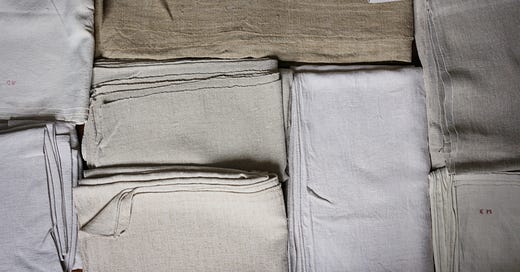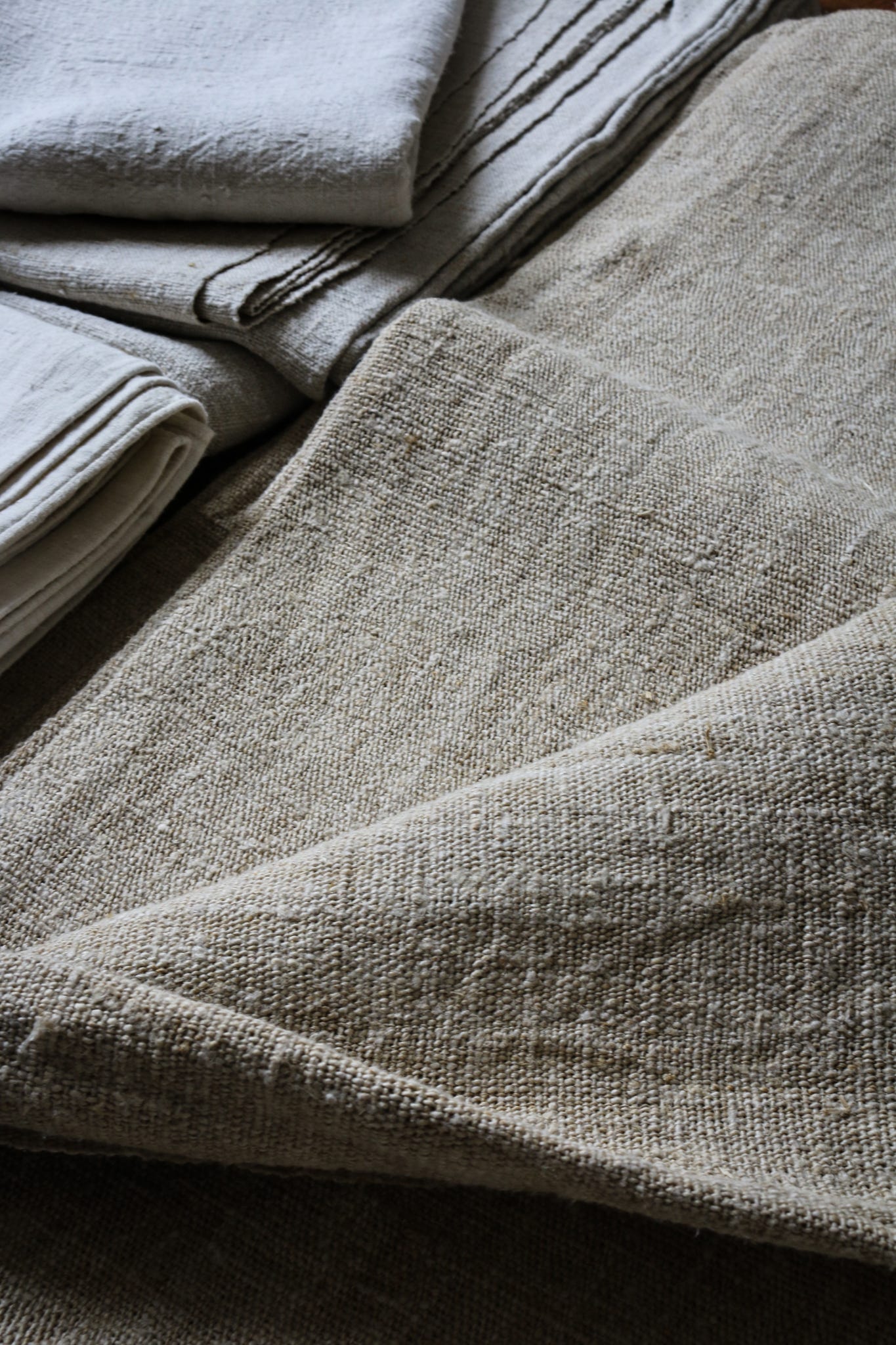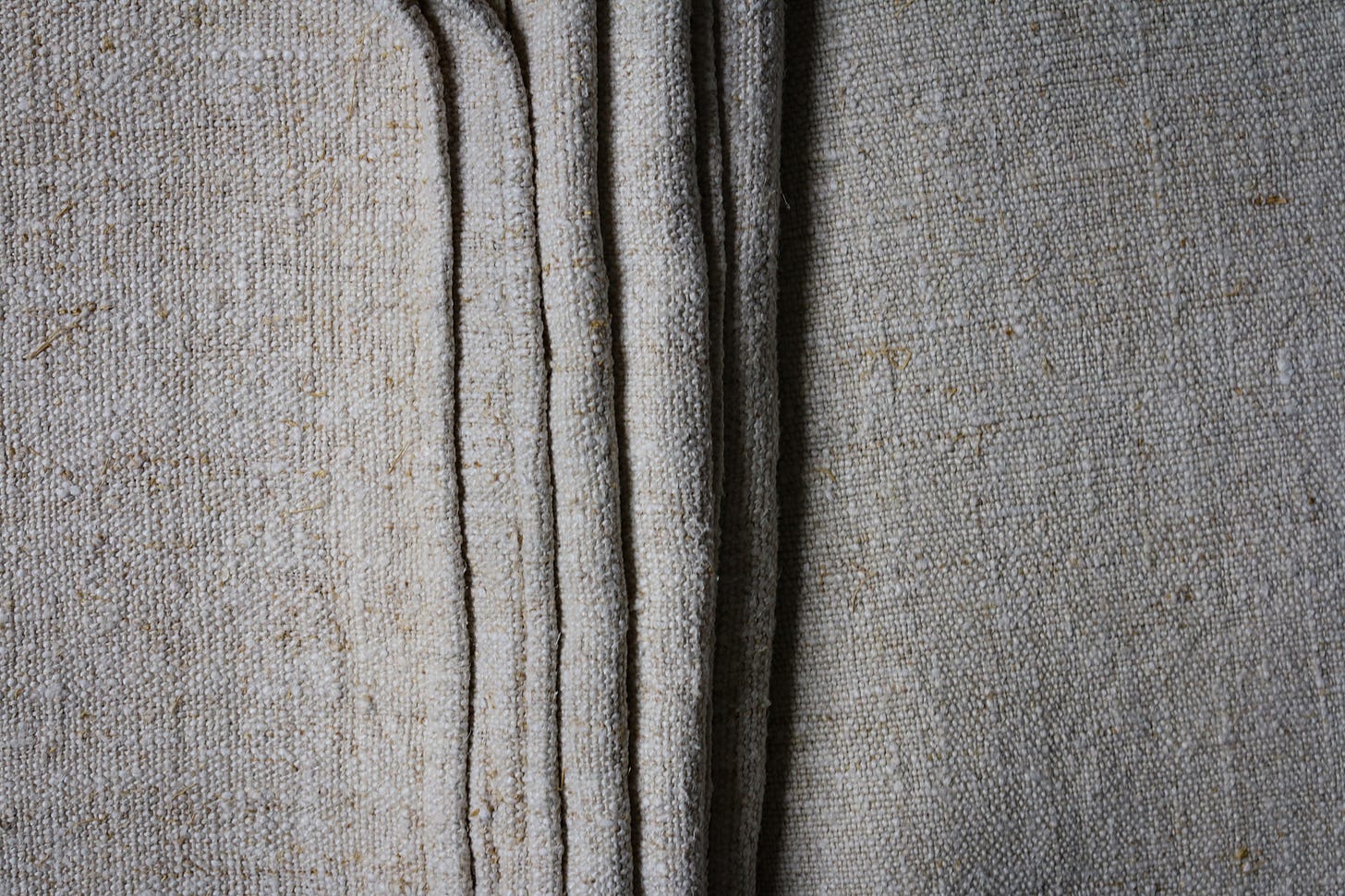So I’ve been away for a little bit. I’ve spent some of that time being the sidekick to the guy who is insulating my attic, a quite big job given that the attic is 100 metres square, windowless, and all the floorboards and paper stuffed underneath had to be removed and taken out down the ladder staircase which is literally 30cm from the toilet and can only be accessed by sliding past the bowl. And then all the new insulation had to be vacuumed in and now Marc is stolidly carting all the new floorboards up one flight of stairs and the terrible toilet-ladder and nailing them down.
It’s going to look wonderful when it is finished - up there, glowing in the dark. I can lie in bed and picture it floating above me. One day I might be able to afford to put a window in the roof.
The other thing that is occupying all my time at the moment is curating and sorting through almost eight years of this business. Yep, today marks eight whole years that I came to this place by accident, got stuck, and then of necessity built a whole strange business from scratch, which eventually allowed me to buy the house where said attic is currently being re-insulated.
I really wanted to insulate the attic with hemp, which is a possibility here in France, but I live in a pretty remote and rather poor area of France and we are not very well-served by crunchy hemp-insulation suppliers, who tend to congregate in the more bougie regions. And trucking in that much hemp would cost more than the hemp itself. So instead we used cellulose fibre, made from broken-down and recycled paper (medicine labels, by the small scraps that remained with words intact on them!). This is beautifully logical - the attic was insulated with scrap paper to start off with - just not very much or very effectively. In fact, I found five garbage bags worth of receipts from the old garage that used to be here, all dated from between 1919 to 1941 - beautifully written with stamps from Michelin, Citroën, De Dion-Bouton etc. So I am keeping with tradition, I feel. The new cellulose looked like beautiful white blossoms when it was all shredded and vacuumed in, and when the whole attic was completed, before Marc started putting the floorboards on, it looked like something wonderful from a Dr Seuss book, something that six-year-old me would have wanted to sleep in.
But hemp is why my business exists, and eventually I hope to use some hemp in renovating the house, be it hempcrete bricks to build a new wall, or semi-rigid hemp insulation panels on the outside of the covered passage, or the traditional hemp and lime render with which I hope to be able to do all of the ground-floor walls in. Hemp is what allowed us to survive here. Hemp saw us through seven house moves in six years, and in my moments of deepest depression, when I couldn’t go back but dreaded going forward, just rearranging and touching my hemp collection would soothe me. Until finally, hemp, and everything that came after, allowed us to come to a stop.
Having been in this house for over a year now, I have stopped having anxiety that we might need to move again, but it has taken a while. The lack of anxiety, and not needing to move has allowed me finally to take stock of what I have, what I do, what I want to do, and why. And this is the other reason I’ve been a bit absent here, and also doing the bare minimum for the technofascist platform we all know and love (hi Instagram!) . It’s because I am finally going through everything I have set aside for some distant future and working out what to do with it. That distant future turns out to be now!
In amongst all the pieces I had set aside to ‘do something with’ there are a multitude of pieces I’ve kept because they are amazing. By a multitude I mean more than a normal person could ever use in three lifetimes. You must understand that I started this business in possibly the last window of time when really, truly amazing textiles regularly turned up in quantities in the brocantes I frequent. And, though I say so myself, this is not my first go on the roundabout - I’ve been collecting and obsessing about, working with and dealing in textiles since my early twenties, and have done so now in several different countries. So I know what to look for, although I have been on a steep learning curve re: French textiles for years, and there is still so much to know.
And finally I am incessantly curious, which led me right from the get-go to talk to everyone in my shitty French, then my not-so-shitty French, and then my quite damn good French. And along the way I met lots of dealers, and made networks of people who knew what I was doing, and who Found The Things and Passed Them Onto Me and taught me how to speak proper, and swear like a brocante dealer, and drink neat black coffee at 5am on a freezing cold winters morning (one of these people, Martine, said recently through a cloud of cigarette smoke, when I self-corrected the gender of a noun I had misgendered ‘You owe me so much…’, and she was right).
So, I have so much stuff. And over the coming weeks and months a lot of it is going up on my website - there’s been quite a bit there already, but I haven’t even gotten to see the floor yet.
But what started me was hemp - a load of hemp sheets from a spectacularly rude dealer called Philippe who, eight years ago, couldn’t be arsed with the heavy, dirty things, and sold them to me at what is now a stupid price, and delivered them to my then-front door, just around the corner from the bi-weekly flea market, in order to be rid of them. (We later had several knock-down drag out fights, me yelling like some trashy banshee in terrible French, first when he was really insultingly rude to an elderly man who had asked him the price of something, and then when he gave me a ridiculously high price for several things I dearly wanted, and ended up getting - a 19th century mariners waistcoat and two very old embroidered Greek blouses, all of which I still have. But don’t try this as a bargaining tactic unless you truly know the psychology of your opponent. After these two incidents he became rather friendly towards me although someone subsequently told me it was because he’d finally convinced a woman to like him enough to be seen in public with him).
I was entranced by these textiles. I’d never seen anything like antique French hemp. I knew nothing about it, least of all what I was going to do with a number of broken smelly cardboard boxes full of hemp sheets when we didn’t even have winter shoes. But I had to know more - which is the way everything always works for me. I am curious to the point of being nosy, and once I get a bone in my teeth I will worry it to death.
I broke the ancient washing machine in our airbnb’d first house, which I didn’t feel bad about at all because the owner was a dick - and stuck the results up on Instagram - just to share because they were amazing - and someone asked if they were for sale.
So eight years later, a lot of hemp sheets have passed through my hands, but less and less. I used to find maybe two or three really excellent hemp sheets a week - it’s been months now since I found a single one worth bringing home. But I have learnt so much about this now-extinct textile - by which I mean handspun and handwoven French hemp. And I have a small collection of hemp sheets, and this is the first time I have managed to get them all in one place. I thought I could sell some, but though I have managed to prise some linen pieces, and some hemp and linen métis pieces, out of my own cold dead hands, the hemp sheets remain firmly stuck.
But as I sorted through them, I realised that they perfectly display why handmade textiles are so amazing. Look at the different colours of these sheets - all of them 19th century handspun and handwoven hemp, most from the areas around Tours and Saumur, or further north into the Sarthe, or northwest in the nearby Vendée. But even between these four départements we are talking a fairly small area of the world. A small area to produce such a huge contrast in colour.
These sheets display the ‘terroir’ of handmade cloth. Terroir is the French word for the time and the place that influences a thing, a person, a food. It is most often used with food, specifically wine, to talk about the region, the soil, the vintage. As an example, even AOP (appellation d’origine protégée) wines which are all made in a very specific small region using only the prescribed grape varieties and methods of cuvage can still taste very different from one vineyard to another, and from one year to another. The last region I lived in before I moved here to peasant goat-cheese land is an area which is very famous for its wine, AOP Saumur-Champigny. It is possible to drive around the entire area in a complete circle in about forty minutes, and from one side to the other of that circle is at most 25-30km, so all of those variations in taste between the vineyards who are allowed to use the protected name are coming down to the very small variations of the soil and the micro-climates, plus the climate on the year the grapes were grown. This is terroir.
And it is the same for textiles. Or it was. The variations in colour you can see in these sheets are from local soil conditions, from weather conditions. They are from the plants themselves - there were once so many different sub-species of hemp for textile, especially around the Touraine and the Vendée, where hemp was the main textile for the vast majority of the peasant population. There used to be hemp species that grew fine and thin and only as high as your kneecap - specifically for making clothing out of. I have one - ONE - piece of this. That species went extinct maybe 100 years ago, and now it is gone for good. Many of the species that these sheets were made out of probably were very local and are also now gone. Those old grainy photos you sometimes see, of hemp farmers standing next to toweringly high plants - those plants weren’t textile hemp - that was rope or paper hemp. There were different species for different end uses, just as there are today. Hemp is still grown in France, it never stopped being grown, for oil seeds and for animal fodder and even for insulation, mixed with lime, a technique used for many centuries, or wrapped around piping, as one of my plumbers did when he was fixing a leaking hot water pipe in our first house. But textile hemp had all but died out, although in the last decade a collaboration of farmers and industrial weavers has seen a rather wonderful project for the revival of French hemp textile come into being, and you can now buy French hemp denim jeans, although they are not cheap. But the textiles you see here, they are long gone, they were pretty much all over and done with by the 1920’s, and they won’t come again because the labour involved was extreme.
The sheet in the foreground of this picture has never been used and is the single heaviest and most thickly-woven of any hemp sheet I’ve ever found, clocking in at around 4kg
The variations in colour are also down to how the fabric was retted - how the external stalk was rotted away to allow the softer inner fibres to be accessed. With linen, this process can be done in the fields, by cutting the flax and letting it sit and begin to decompose - hence ‘field-retted linen’. But hemp needs water to rot in, and so for several weeks each year, a disgusting process would take place in specific parts of the river systems - each farm allotted its own retting spot (you can still see these spots in certain sections - I have had them pointed out to me on the banks of the Cher by a very elderly man). Apparently the smell was so disgusting that someone told me in their community you could do this on a small scale at home but only if you really hated your neighbours. It polluted the water for the whole of those weeks, and made it unusable for drinking or washing. This is also the reason that hemp was never able to be industrially upscaled for production the way linen was - pre the modern era, the necessary step of retting it would consume so much water that it simply wasn’t possible to mass-manufacture it for textile, despite the speed with which the plant grows.
And then there is the variations in weave - which come from the variations in spinning. Is the thread tightly or loosely spun? Is it loosely spun and then tightly woven, creating a heavy but flexible textile. Is it tightly spun and tightly woven (not done much with hemp because of the intense labour involved but done often with linen, which was easier to spin, and particularly with mechanically woven linen and cotton) but this would produce canvas. Loosely spun and loosely woven was often used in mechanical weaving of linen for producing sacking or the fabric used in the first layer of upholstery - it is cheaper to produce, quite strong if not subject to much vigorous movement, but useless if pulled from the sides. Tightly spun but loosely woven produces netting.
And then there is the style of weave, although all of these examples here are plain, or tabby, weave.
So you can see that there is so much to take into consideration. The only way I can be 100% sure that something is hemp when eyeballing it doesn’t suffice is by feel, and by looking at the drape. Even then, occasionally I am not sure (hint to people who send me pictures on Instagram asking me to identify if their random sheet is hemp or linen - I can’t). It warmed the cockles of my heart when years ago a reader messaged me to say that she was a textile curator in a museum in Denmark, and that sometimes the only way to tell if something very old is hemp or linen is to look at it under a microscope. I still haven’t done that - I should! But I must add that age and wear and the way it flattens out and compresses the fibres can make a considerable difference to the feel and drape and look of a handwoven fabric, and compounds the difficulties in telling fine hemp from linen in very old pieces.
Lastly, age and use both bleach out linen and hemp. Linen tends to whiten to a beautiful cream. Hemp tends to turn bone white, but sometimes both textiles turn grey with use. You can see in this collection that several pieces are white, one of these is white through use, one of these (the one with initials EM in the very first picture) is white because actually it’s a rather rare métis of handspun hemp and handspun cotton.
Next I think I will show you my linen collection. Oh I have one of those too! And the variations in colour and weave are even more extreme
Housekeeping: Paid subscribers - your subscription has been on hold since early January when I realised I had too much going on, so you haven’t been billed - please don’t panic!
The website is up and running as always. Stuff being added all the time but it does take me a while to prepare, photograph and upload pieces. I tend to put new things in the webshop up in Instagram stories just to alert people to new stuff, because I can’t do drops and am loathe to send you newsletters for every little damn thing.
Raffles for Abdalla will start up again very shortly. As I have collected rather a number of new followers, just a word - I write a lot about colonialism and white supremacy in textiles, and my writings would be empty if I didn’t extend those ideas to encompass actual modern-day colonialism and white supremacy, especially the horrific live-stream we are all watching on our screens daily. If you are offended by the idea of a Palestinian state and Palestinian safety and self-governance, nothing I do or have is of interest to you, and you can go quietly away now.
The rest of you - xoxox










All I can say is thank goodness for your obsession, with textiles and especially with hemp, and your love of writing so that we get to read your fascinating insights and share in your knowledge. And I'm glad your home is coming on and that you feel settled.
I simply love your newsletters and your no-compromise views on Palestine. I have learned so much from you about textiles. Thank you! Glynis